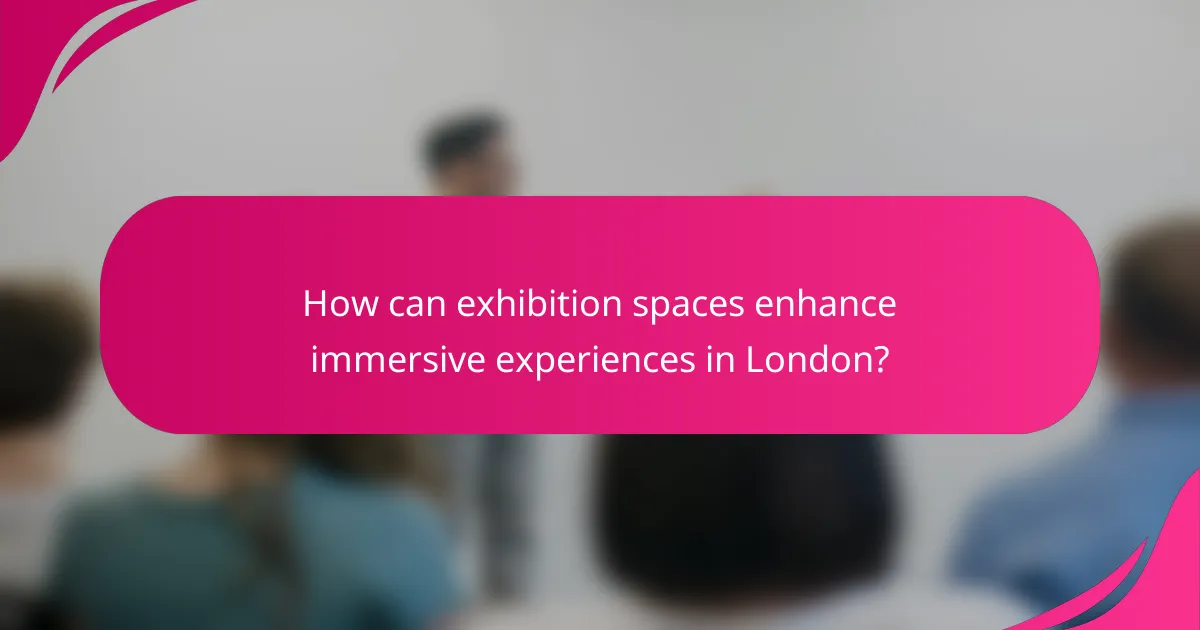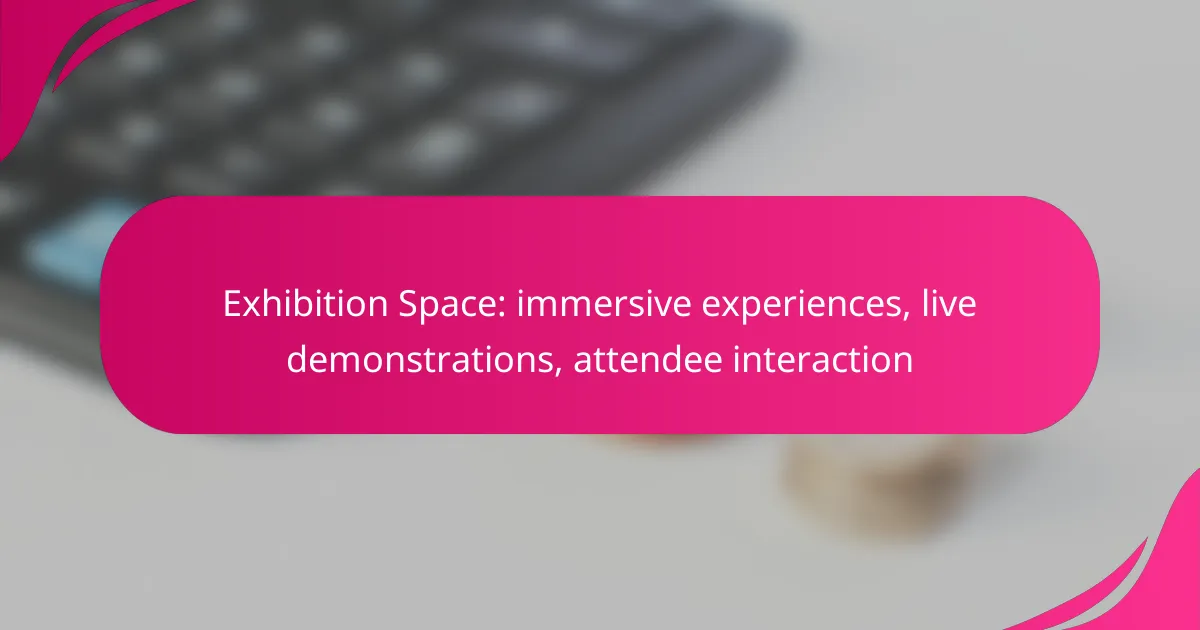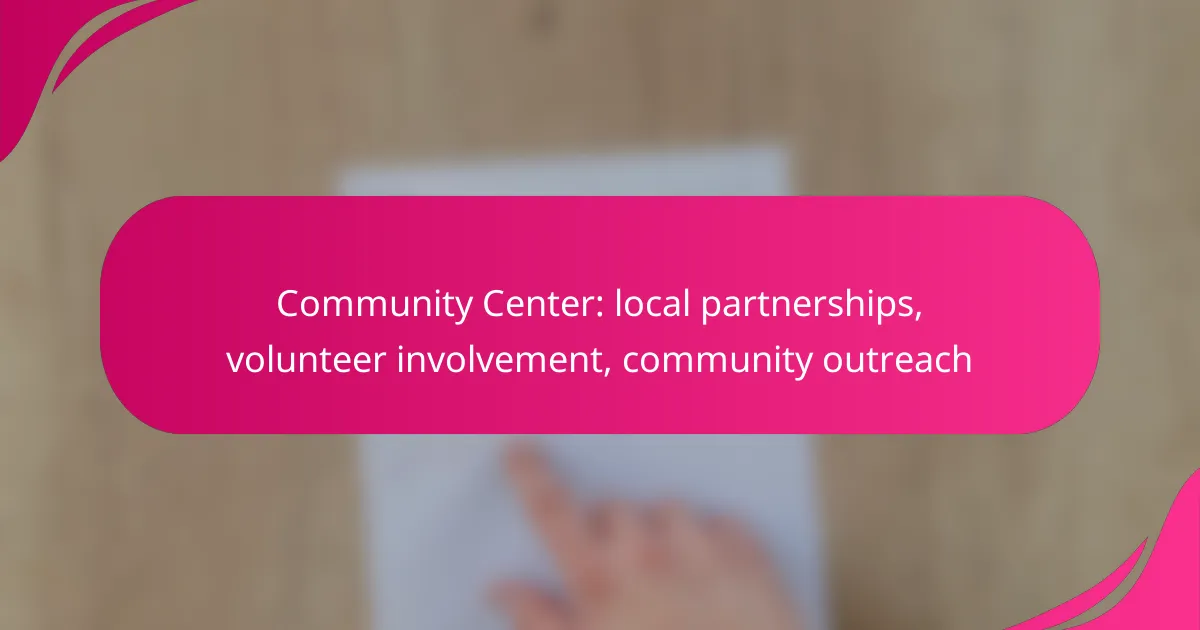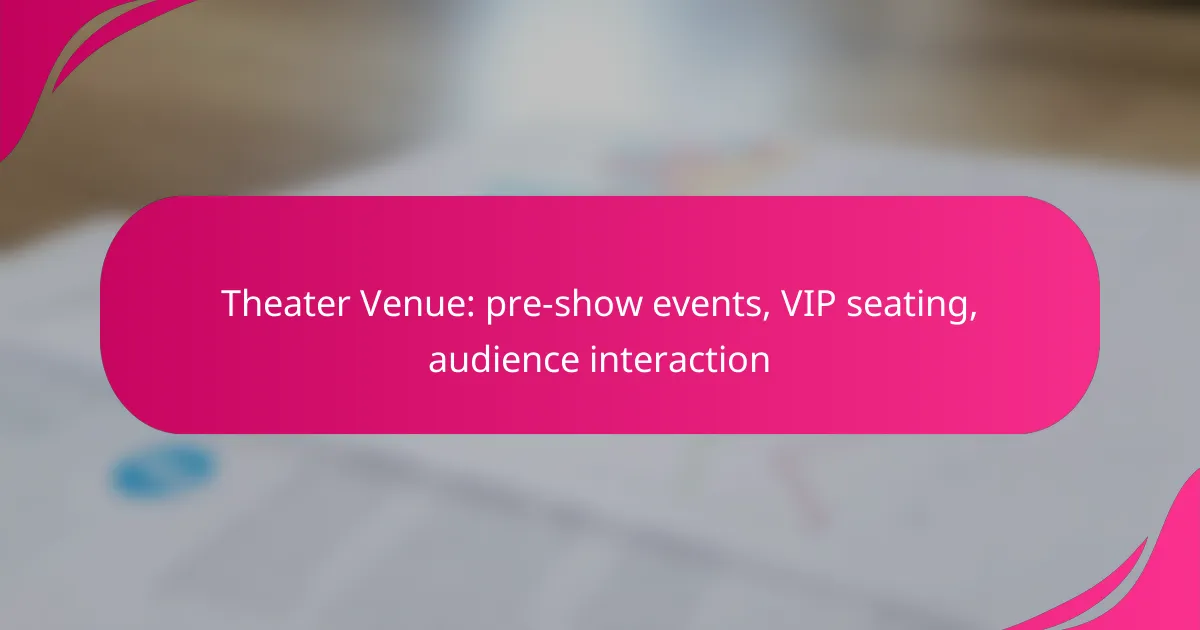Exhibition spaces are designed to elevate immersive experiences by incorporating cutting-edge technology and interactive elements that captivate attendees. Live demonstrations, ranging from product launches to culinary showcases, provide opportunities for visitors to engage directly with innovations. By fostering attendee interaction, these events create memorable connections and a deeper understanding of the exhibits on display.

How can exhibition spaces enhance immersive experiences in London?
Exhibition spaces in London can significantly enhance immersive experiences by integrating technology and interactive elements that engage attendees. These enhancements create memorable interactions, allowing visitors to explore and connect with exhibits in innovative ways.
Virtual reality installations
Virtual reality (VR) installations transport attendees into fully immersive environments, providing experiences that are often impossible in the real world. These setups typically require VR headsets and can simulate various scenarios, from historical events to futuristic landscapes.
When planning a VR installation, consider the space needed for movement and the number of users that can participate simultaneously. A well-designed VR experience can captivate audiences, but ensure that the technology is user-friendly to avoid frustration.
Augmented reality applications
Augmented reality (AR) applications overlay digital information onto the physical world, enhancing the visitor experience without the need for specialized equipment. Attendees can use their smartphones or tablets to interact with exhibits, revealing additional content such as videos, 3D models, or detailed information.
To implement AR effectively, ensure that the content is relevant and enhances the understanding of the exhibit. Clear instructions on how to access AR features will improve user engagement and satisfaction.
Interactive art exhibits
Interactive art exhibits invite attendees to engage directly with the artwork, often allowing them to manipulate elements or contribute to the creation process. This type of engagement fosters a deeper connection between the audience and the art, making the experience more personal and memorable.
When designing interactive art, consider the balance between accessibility and complexity. Simple interactions can attract a broader audience, while more complex setups may appeal to niche groups. Providing guidance and support can enhance visitor participation and enjoyment.

What live demonstrations attract attendees in the UK?
Live demonstrations that attract attendees in the UK often include product launches, culinary showcases, and technology demonstrations. These events engage visitors through interactive experiences, allowing them to see, taste, and understand innovations firsthand.
Product launches by major brands
Product launches by major brands are a significant draw for attendees, as they often feature exclusive previews of new items. Brands like Apple and Samsung frequently host events that allow consumers to experience their latest technology before it hits the market.
Consider incorporating interactive elements, such as hands-on trials or Q&A sessions with product experts, to enhance attendee engagement. These experiences can lead to increased brand loyalty and immediate sales opportunities.
Culinary showcases by Michelin-star chefs
Culinary showcases featuring Michelin-star chefs provide a unique opportunity for attendees to witness high-level cooking techniques. These demonstrations often include live cooking sessions where chefs prepare signature dishes, allowing participants to taste the results.
To maximize engagement, consider offering cooking classes or tastings alongside the demonstrations. This not only enhances the experience but also encourages attendees to interact with the chefs and ask questions about their culinary methods.
Technology demonstrations by startups
Technology demonstrations by startups are increasingly popular, showcasing innovative solutions in various industries. These events allow attendees to explore cutting-edge technologies, such as AI applications or sustainable products, in an interactive setting.
Encouraging feedback during these demonstrations can provide valuable insights for startups. Offering hands-on experiences or pilot programs can also help attendees understand the practical applications of the technology being showcased.

How does attendee interaction improve engagement?
Attendee interaction significantly enhances engagement by actively involving participants in the experience. This involvement fosters a sense of ownership and connection, making the event more memorable and impactful.
Live polling and feedback systems
Live polling and feedback systems allow attendees to express their opinions in real-time, creating a dynamic atmosphere. By using mobile apps or interactive displays, organizers can gather instant insights on topics, preferences, or satisfaction levels.
Consider incorporating simple yes/no questions or multiple-choice polls during presentations. This not only keeps the audience engaged but also provides valuable data for future events. Aim for a response rate of at least 30-50% to ensure meaningful feedback.
Networking opportunities through workshops
Workshops provide structured networking opportunities that encourage attendee interaction. By facilitating small group discussions or hands-on activities, participants can connect over shared interests and experiences.
To maximize networking, consider scheduling workshops with specific themes relevant to your audience. Keep group sizes manageable, ideally between 8-15 participants, to foster meaningful conversations and connections.
Gamification elements in exhibits
Incorporating gamification elements into exhibits can significantly boost attendee interaction and engagement. This can include challenges, quizzes, or scavenger hunts that encourage participants to explore the exhibit more thoroughly.
For effective gamification, ensure that the rewards are appealing, such as discounts, exclusive content, or prizes. Aim for a balance between fun and educational content to maintain interest without overwhelming participants.

What are the key features of successful exhibition spaces?
Successful exhibition spaces are characterized by their ability to engage attendees through immersive experiences, live demonstrations, and interactive elements. Key features include flexible layouts, high-quality audiovisual equipment, and accessibility options that cater to all visitors.
Flexible layout options
Flexible layout options allow exhibition spaces to adapt to various types of events and audience sizes. This can include movable walls, modular furniture, and open spaces that encourage flow and interaction. Consider using different zones for demonstrations, networking, and relaxation to enhance attendee engagement.
When planning the layout, think about how attendees will navigate the space. A well-thought-out flow can prevent congestion and ensure that visitors can easily access key areas. Utilize 3D modeling tools to visualize the space before setup.
High-quality audiovisual equipment
High-quality audiovisual equipment is essential for creating an engaging atmosphere in exhibition spaces. This includes large screens, projectors, sound systems, and interactive displays that capture attention and convey information effectively. Ensure that the equipment is compatible with various media formats to accommodate different presentations.
Investing in reliable technology can significantly enhance the attendee experience. For instance, using high-definition video can make live demonstrations more impactful, while clear audio ensures that presentations are easily heard. Regularly test equipment before the event to avoid technical issues.
Accessibility features for all attendees
Accessibility features are crucial for ensuring that all attendees can fully participate in exhibition spaces. This includes wheelchair ramps, designated seating areas, and clear signage that accommodates individuals with disabilities. Compliance with local regulations, such as the Americans with Disabilities Act (ADA) in the U.S., is essential.
Incorporating assistive technologies, such as hearing loops and captioning services, can further enhance accessibility. Providing materials in multiple formats, such as braille or large print, ensures that everyone can engage with the content. Regularly seek feedback from attendees to improve accessibility features for future events.

What criteria should be considered when choosing an exhibition space?
When selecting an exhibition space, consider factors such as location accessibility, capacity and layout flexibility, and technical support availability. These elements significantly influence attendee experience and engagement, impacting the overall success of the event.
Location accessibility in London
Location accessibility is crucial for attracting attendees to your exhibition in London. Choose a venue that is easily reachable via public transport, including underground stations and bus routes, to maximize foot traffic.
Additionally, consider proximity to hotels and restaurants, as this enhances convenience for visitors. Venues in central areas like Westminster or the City of London typically offer better accessibility, but may come at a higher cost.
Capacity and layout flexibility
Evaluate the capacity and layout flexibility of the exhibition space to accommodate your expected number of attendees and the type of immersive experiences you plan to offer. Spaces should allow for various configurations, such as open layouts for demonstrations or segmented areas for workshops.
As a rule of thumb, ensure the venue can comfortably hold at least 20-30% more attendees than your maximum estimate to avoid overcrowding. This flexibility can enhance attendee interaction and engagement during the event.
Technical support availability
Technical support availability is essential for a seamless exhibition experience. Ensure the venue provides reliable Wi-Fi, audio-visual equipment, and on-site technical assistance to handle any issues that may arise during live demonstrations.
Check if the venue has experience hosting similar events, as this can indicate their ability to meet your technical needs. Having a dedicated support team can significantly reduce stress and ensure that your immersive experiences run smoothly.



